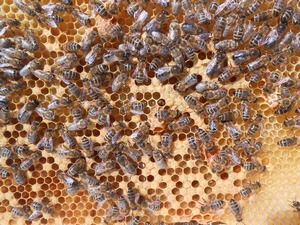The Life of A Drone

Queens, workers and drones are all different from each other in structure. The differences have to do with the activity that each kind of bee has in the colony. The drones mate with the queen. The larger eyes and better vision of the drone probably help it to find the queen more easily during mating flights. The longer antennae, with their extra sense organs, also probably help it find the queen.
The droneā€™s special structures do not make them fit for any other activity in the hive. For example, drones have no sting so they cannot defend the colony. They are also unable to do any other of the worker's tasks, such as farming the hive or collecting nectar. Scientists say they are specialized. Drones are very important however, because without them there would be no more fertilized eggs and no more workers or queens, and therefore no bees.
Each afternoon during summer, the drones from many colonies tend to collect in one place and fly around for about two hours. Whenever a new queen leaves on her mating flight, it is thought that she is attracted to the drone meeting place. The scent of the queen bee is attractive to the drones when they are flying around outside the hive. It is not at all attractive to them inside the hive. Great numbers of drones chase after the queen. About seven drones, in turn, over take her and mate with her while flying, giving her all the sperm she will need to fertilize eggs for her entire life. Each drone mates within three seconds after catching the queen. Immediately after, the drone falls to the ground, unable to move. He soon dies. When the queen finishes mating, she returns to the hive and does not mate for the remainder of her life. There are hundreds or thousands of drones for each queen that mates. Most drones live their entire life without ever mating with a queen. As fall approaches and the weather becomes cool, workers stop feeding the drones. Some drones then leave the colony and starve to death. Others are pushed out by the workers. Soon there are no drones left, and no mere are produced until the next spring.
Raising bees that are especially efficient at pollinating flowers or at making honey, has only become possible in recent years. This is because different breeds have different pollinating activity. To produce desirable breeds, mating has to be controlled, and controlling the mating of bees is very hard.
One way is to produce thousands of drones of the right kind and to allow them to fly near the place where the queen will take her mating flight. Hopefully the queen will mate mostly with the right kind of drones. This is not a very exact method, but drones will not mate with a queen inside a flight chamber where it would be easier to control things.
Another way is to remove the sperm from the right kind of drone and inject it into the sting chamber of the chosen queen, where drones normally would have placed the sperm. This delicate operation is done by putting the queen to sleep and holding her under a microscope. With this complete control of mating, all kinds of bees can be produced. For example bees have been produced that prefer to collect food from certain kinds of plants, such as alfalfa.
The Bees section was created with special thanks to Louis Juers (Arizona State Parks & Trails) for providing information used in this section. Additional information and digital materials were obtained from some of the following organizations. We would like to thank them for all their dedication and hard work within their profession.
|









